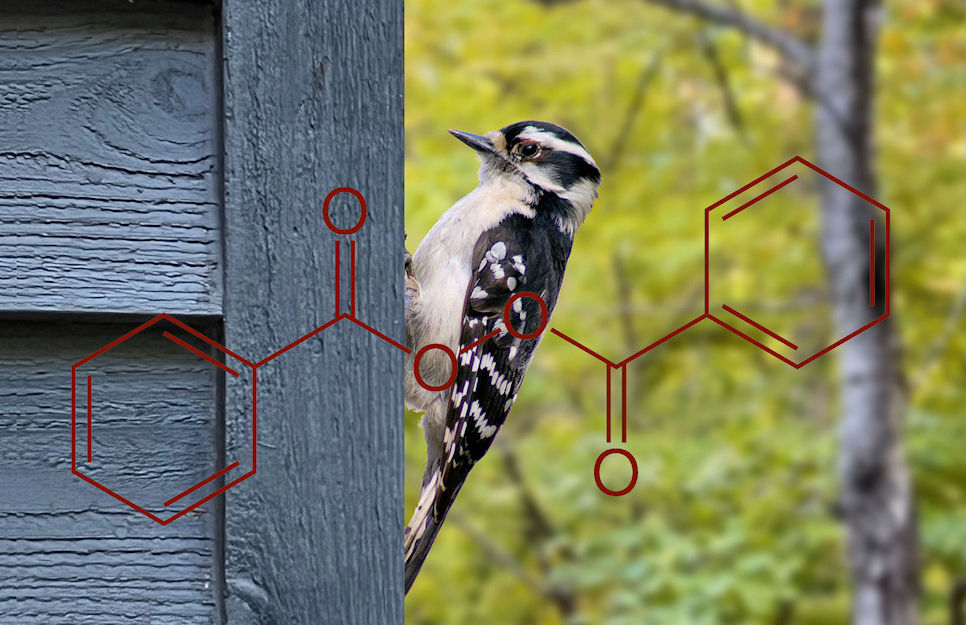
Benzoyl peroxide structure over a Downy woodpecker on cedar siding.
American Chemical Society | Industry | Industry Matters Newsletter | Woodpecker Chemistry
Woodpecker Chemistry
Industry Matters Newsletter 3 November 2022
My yearly battle with the woodpeckers bent on destroying my house is now in full swing. As the days shorten, the hairy and downy woodpeckers start aggressively attacking the house’s cedar siding. It is a time I am particularly grateful for chemistry, an integral part of my yearly fight with the woodpeckers.
For any that jumped to the conclusion I’m poisoning woodpeckers, relax. I am not. The woodpeckers are safe and sound.

Benzoyl peroxide structure over a Downy woodpecker on cedar siding.
I’ve tried many solutions over the years. The one I’ve settled on makes me grateful for chemistry. I use chemical tools to repair the damage, a reactive, unsaturated polyester wood filler. It is a two-part system that hardens in mere minutes. Mixing resin with a dab of hardener gives me only a few minutes of pot life. I can seal a hole with a plug as hard or harder than cedar siding in the time it takes me to descend my ladder. By the time I ascend again, it is ready for paint. All the other solutions I’ve tried required days of drying and reapplication. I’m not particularly scared of heights, but I do possess the good sense to fear falling. The rapid cure of the wood filler enables the fewest trips up and down the ladder. For that I am grateful, grateful for the chemistry that enables it.
The polyester resin I purchase is a metastable system. These materials happily sit in the can, but they are itching to react. The trigger to initiate the reaction of my wood filler is itself a high-energy material, an organic peroxide. Adding peroxide releases the chemical energy, creating heat as monomers are turned to lower energy polymers. Peroxides are themselves metastable and are products of some pretty tricky chemistry. The chemical industry produces a variety of peroxides used in polymer and rubber chemistry, medicine and disinfection. The initiator used in my wood filler is benzoyl peroxide, the same peroxide used in over-the-counter acne medicines. It is handled safely day in and day out in many sectors of society, yet it is a dangerous material. First, it is hazardous in both skin and eye contact. Its use in acne treatments relies on it both killing bacteria and skin. Heating benzoyl peroxide can result in an explosion.
Hurricane Harvey’s assault on the Houston area provided a window on the production of organic peroxides and the inherent dangers. It exposed the bravery of industry workers faced with dire conditions and dangerous materials. It exposed the layers of protection philosophy common in industrial safety. It also exposed how failures can still occur.
Staff at Arkema’s Crosby, TX site knew the hurricane was coming. The organic peroxides made at the site were, like all peroxides, thermally unstable. Safety storage and handling required refrigeration. Back-up generators are one of the layers of protection present on the site. Loss of utility power should not have been an issue. Chemical production benefits from increasing scale. It is the primary way costs are reduced throughout the chemical industry. As Harvey pounded Houston, scale became a problem. Scale meant there was a concerningly large inventory. A little bit of a thermally unstable compound heating up is a problem. Large amounts of thermally unstable material heating up is an event. Harvey knocked out utility power and soon rising waters flooded the generators. Faced with large quantities of warming, thermally unstable products, there was a plan. The next layer of protection was refrigerated trailers. Inventory was moved from buildings into trailers, each with its own refrigeration system. The CGI movie created by the Chemical Safety Board details the actions taken and where they fell short. The flood waters ultimately swamped the layers of protection, flooding the fuel tanks and wrecking the refrigeration. The inevitable decomposition and fires happened. The large column of black smoke made the news, another toxic chemical story. The CSB report paints a more positive than negative picture. Safety was thoughtfully considered. Plans were in place and followed. Communication with emergency personnel was occurring. A 100-year flood would have been no problem. Same for a 500-year flood. Harvey was bigger.
Felony charges for reckless emission of air pollutants were filed by Harris County, the county where the plant is located. In October of 2020, it was dismissed with no convictions. The judge Civil trials continue. Arkema contends the events were a result of a natural disaster. They state the employees acted heroically. The CSB report leads me to the same conclusion.
The video and reports are worth a look. They provided me with new respect for the industrial workers tasked with making peroxides. As I am typing this, the woodpeckers are pecking at my siding. I’m thankful for the peroxides and those that produce them. My go-to solution for living with woodpeckers relies on them.